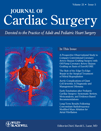Rupture of Aortic Pseudoaneursym Arising from a Transverse Aortotomy Line 12 Years Following Mechanical Aortic Valve Replacement
Conflict of interest: None
Abstract
Abstract Pseudoaneurysm formation at the site of aortotomy is a rare complication following aortic valve replacement; it appears to be more common in those whose valve is replaced for endocarditis or in those who develop an early postoperative endocarditis or sepsis. We discuss the case of a 77-year-old male, who presented 12 years following mechanical aortic valve replacement, with rupture of an ascending aortic pseudoaneurysm arising from a transverse aortotomy line. (J Card Surg 2010;25:563-565)




